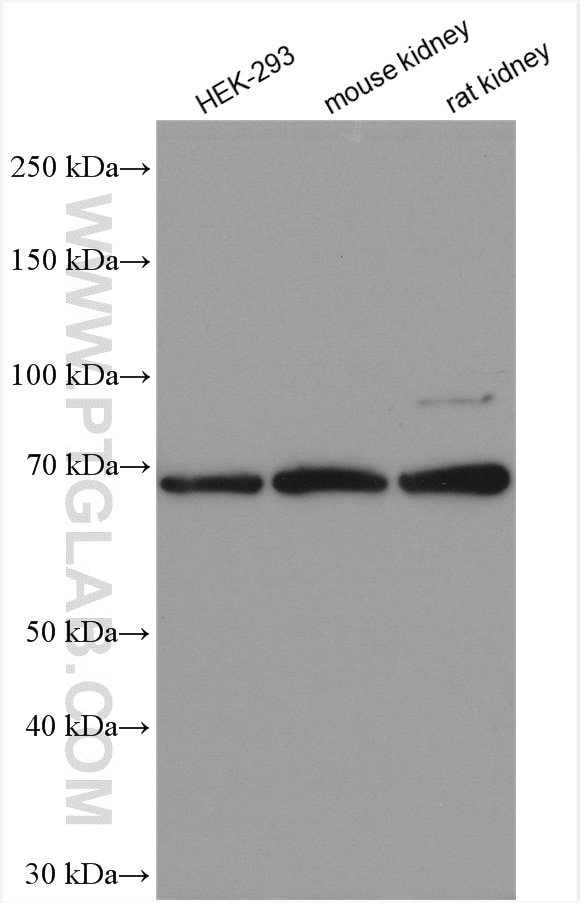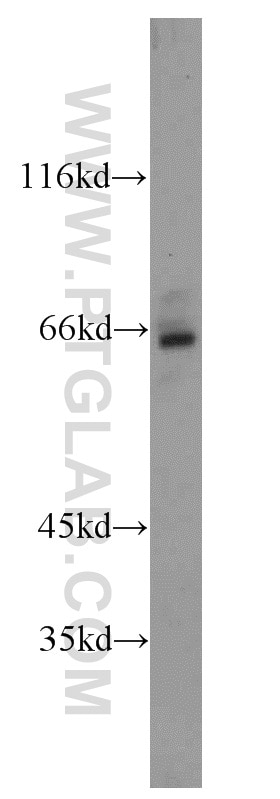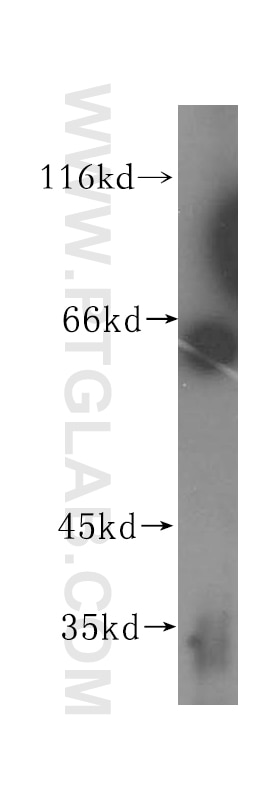- Phare
- Validé par KD/KO
Anticorps Polyclonal de lapin anti-HEXB
HEXB Polyclonal Antibody for WB, IHC, ELISA
Hôte / Isotype
Lapin / IgG
Réactivité testée
Humain, rat, souris
Applications
WB, IF, IHC, ELISA
Conjugaison
Non conjugué
N° de cat : 16229-1-AP
Synonymes
Galerie de données de validation
Applications testées
| Résultats positifs en WB | cellules HEK-293, cellules HeLa, cellules Jurkat, tissu pulmonaire de souris, tissu rénal de rat, tissu rénal de souris |
| Résultats positifs en IHC | tissu rénal humain il est suggéré de démasquer l'antigène avec un tampon de TE buffer pH 9.0; (*) À défaut, 'le démasquage de l'antigène peut être 'effectué avec un tampon citrate pH 6,0. |
Dilution recommandée
| Application | Dilution |
|---|---|
| Western Blot (WB) | WB : 1:500-1:2000 |
| Immunohistochimie (IHC) | IHC : 1:20-1:200 |
| It is recommended that this reagent should be titrated in each testing system to obtain optimal results. | |
| Sample-dependent, check data in validation data gallery | |
Applications publiées
| KD/KO | See 1 publications below |
| WB | See 5 publications below |
| IHC | See 2 publications below |
| IF | See 2 publications below |
Informations sur le produit
16229-1-AP cible HEXB dans les applications de WB, IF, IHC, ELISA et montre une réactivité avec des échantillons Humain, rat, souris
| Réactivité | Humain, rat, souris |
| Réactivité citée | Humain, souris |
| Hôte / Isotype | Lapin / IgG |
| Clonalité | Polyclonal |
| Type | Anticorps |
| Immunogène | HEXB Protéine recombinante Ag8683 |
| Nom complet | hexosaminidase B (beta polypeptide) |
| Masse moléculaire calculée | 556 aa, 63 kDa |
| Poids moléculaire observé | 63-67 kDa |
| Numéro d’acquisition GenBank | BC017378 |
| Symbole du gène | HEXB |
| Identification du gène (NCBI) | 3074 |
| Conjugaison | Non conjugué |
| Forme | Liquide |
| Méthode de purification | Purification par affinité contre l'antigène |
| Tampon de stockage | PBS avec azoture de sodium à 0,02 % et glycérol à 50 % pH 7,3 |
| Conditions de stockage | Stocker à -20°C. Stable pendant un an après l'expédition. L'aliquotage n'est pas nécessaire pour le stockage à -20oC Les 20ul contiennent 0,1% de BSA. |
Informations générales
The HEXB (Beta-hexosaminidase subunit beta) gene encodes the beta subunit of the enzyme hexosaminidase, which is involved in the breakdown of gangliosides. It is responsible for the degradation of GM2 gangliosides, and has a variety of other molecules containing terminal N-acetyl hexosamines, in the brain and other tissues. Refer to the domains of HEXB and glycosylation, there will be some different bands with MW 63-67 kDa precursor; 59-63 kDa signal peptide removed; 50-55 kDa subunit beta (or signal and propeptide removed); 20-25 kDa subunit beta chain B; ~30 kDa subunit beta chain A (Uniprot).
Protocole
| Product Specific Protocols | |
|---|---|
| WB protocol for HEXB antibody 16229-1-AP | Download protocol |
| IHC protocol for HEXB antibody 16229-1-AP | Download protocol |
| Standard Protocols | |
|---|---|
| Click here to view our Standard Protocols |
Publications
| Species | Application | Title |
|---|---|---|
Mol Neurobiol The Role of Oxidized Cholesterol in Diabetes-Induced Lysosomal Dysfunction in the Brain. | ||
Front Cell Dev Biol Identification and Validation of a Nine-Gene Amino Acid Metabolism-Related Risk Signature in HCC. | ||
Front Oncol Microglia-Specific Expression of HEXA and HEXB Leads to Poor Prognosis in Glioblastoma Patients.
| ||
Biol Open Evidence for lysosomal exocytosis and release of aggrecan-degrading hydrolases from hypertrophic chondrocytes, in vitro and in vivo. | ||
J Cereb Blood Flow Metab Characteristics of activation of monocyte-derived macrophages versus microglia after mouse experimental intracerebral hemorrhage |









